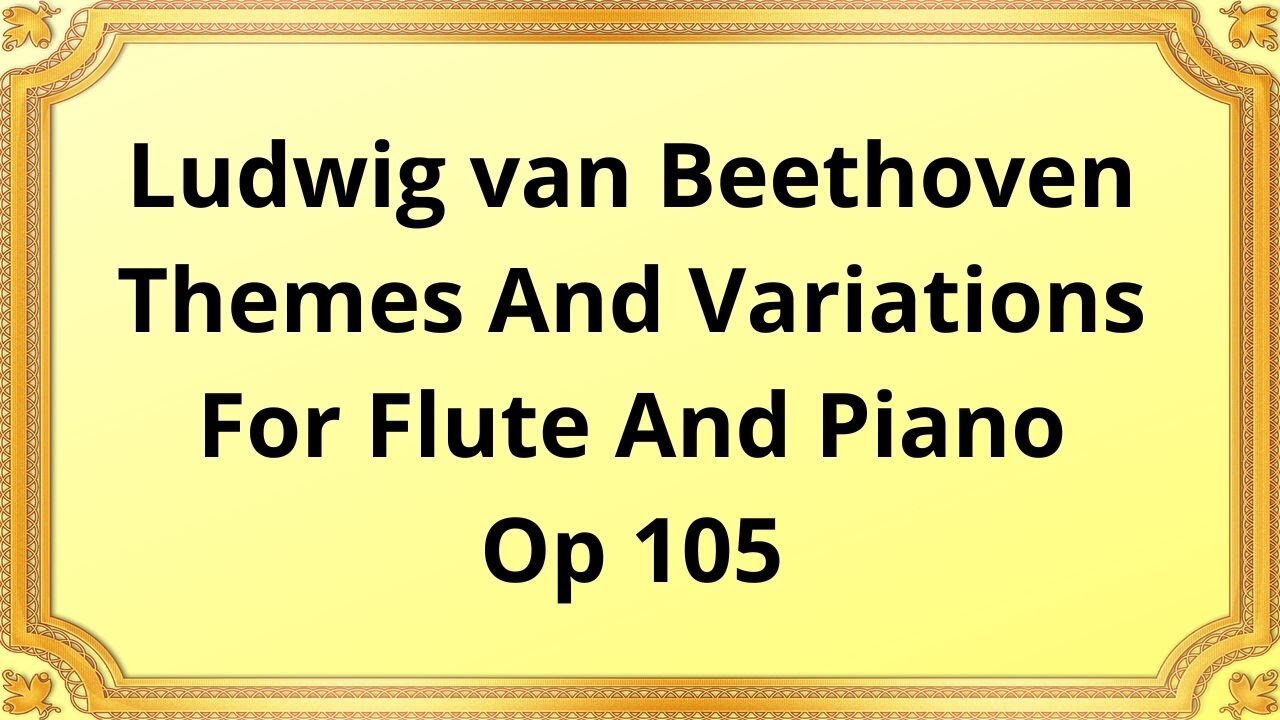Premium Only Content

Ludwig van Beethoven Themes And Variations For Flute And Piano, Op 105
#Beethoven #ClassicalMusic #ThemesAndVariations #FluteAndPiano #Op105 #MusicalComposition #Melody #Expression #Virtuosity #Collaboration #Innovation #EmotionalDepth
Jean-Pierre Rampal, Flute Robert Veyron-Lacroix, Piano
OP. 105, NO. 1 IN G (WELSH AIR ENTITLED ‘‘THE COTTAGE MAID”)
Ludwig van Beethoven's "Themes and Variations for Flute and Piano, Op. 105" is a captivating musical composition that showcases the genius of one of the greatest composers in history. This piece, written specifically for flute and piano, demonstrates Beethoven's mastery in creating intricate variations on a theme, highlighting his ability to explore various musical ideas and emotions.
The composition begins with a charming theme that sets the foundation for the variations to come. The flute takes the lead, introducing the melodic motif, while the piano provides delicate accompaniment. As the variations unfold, Beethoven skillfully transforms the original theme, exploring different musical styles, harmonies, and textures.
One notable aspect of Beethoven's "Themes and Variations" is the virtuosity required by both the flutist and the pianist. The flute part demands technical prowess, with rapid passages, intricate runs, and expressive leaps. The piano, on the other hand, provides a rich harmonic backdrop, complementing the flute's melodic lines with its own intricate patterns and lush chords.
Throughout the piece, Beethoven's innovative approach to composition shines through. He pushes the boundaries of traditional variations by incorporating unexpected harmonic shifts, dramatic dynamic contrasts, and rhythmic complexities. These elements add depth and intensity to the music, captivating the listener and keeping them engaged throughout the piece.
What makes "Themes and Variations for Flute and Piano, Op. 105" truly remarkable is the emotional depth it conveys. Beethoven's ability to convey a range of emotions through his music is evident in this composition. From moments of tender lyricism to passages of fiery passion, the piece takes the listener on an emotional journey, evoking a wide range of feelings.
Furthermore, this composition exemplifies the collaborative nature of chamber music. The dialogue between the flute and piano creates a musical conversation, with each instrument responding and interacting with the other. This synergy between the two instruments adds an extra layer of complexity and depth to the overall musical experience.
In conclusion, Ludwig van Beethoven's "Themes and Variations for Flute and Piano, Op. 105" is a masterpiece of classical music. With its intricate variations, virtuosic performances, innovative approach, and emotional depth, this composition continues to captivate audiences and showcase Beethoven's genius. It stands as a testament to the enduring power and beauty of classical music, leaving a lasting impact on all who have the pleasure of experiencing it.
You have the opportunity to support the channel:
https://destream.net/live/RadSiarAl/donate
https://www.buymeacoffee.com/6355radsiaral
-
 41:38
41:38
Classical music_Music Inspiration
1 month agoNikolai Andreevich Rimsky Korsakov Symphonic Suite “Scheherazade”
1701 -
 2:27:06
2:27:06
Blabs Games
12 hours agoApex Legends With Josiah & Mozz
6.59K -
 1:01:56
1:01:56
BonginoReport
5 hours agoDems Scramble To Rebrand and it’s a BIG FAIL - Nightly Scroll w/ Hayley Caronia (Ep.114)
92.5K97 -
 LIVE
LIVE
Eternal_Spartan
20 hours agoEternal Spartan Plays Final Fantasy 7 Remake Pt. 5 | USMC Vet | Join the Best Chat on Rumble!
62 watching -
 LIVE
LIVE
ZWOGs
6 hours ago🔴LIVE IN 1440p! - Kingdom Come Deliverance, Trying Off The Grid, and More! - Come Hang Out!
36 watching -
 1:10:27
1:10:27
Katie Miller Pod
8 hours ago $1.54 earnedEpisode 2 - Sage Steele | The Katie Miller Podcast
22.6K1 -
 6:32:18
6:32:18
MattMorseTV
10 hours ago $28.81 earned🔴Trump's meeting with Zelenskyy - LIVE🔴
121K83 -
 1:09:56
1:09:56
Kim Iversen
5 hours agoTrump Floats Sending U.S. Troops To Ukraine | Bill And Hillary Clinton Questioned Over Epstein Files
81.9K92 -
 10:02:30
10:02:30
GritsGG
12 hours agoWin Streaking! Most Wins 3390+ 🧠
29.6K5 -
 6:59:19
6:59:19
StoneMountain64
8 hours agoBattlefield 6 Roundup, and NEW MAP for Battlefield 2042 on the Road to BF6
89.6K2